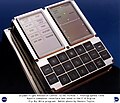Fitxer:Apollo display and keyboard unit (DSKY) used on F-8 DFBW DVIDS683588.jpg
Aparença

Mida d'aquesta previsualització: 765 × 600 píxels. Altres resolucions: 306 × 240 píxels | 612 × 480 píxels | 980 × 768 píxels | 1.280 × 1.004 píxels | 2.560 × 2.007 píxels | 3.030 × 2.376 píxels.
Fitxer original (3.030 × 2.376 píxels, mida del fitxer: 6,18 Mo, tipus MIME: image/jpeg)
Historial del fitxer
Cliqueu una data/hora per veure el fitxer tal com era aleshores.
| Data/hora | Miniatura | Dimensions | Usuari/a | Comentari | |
|---|---|---|---|---|---|
| actual | 07:29, 9 oct 2021 |  | 3.030 × 2.376 (6,18 Mo) | Huntster | Cropped 9 % vertically using CropTool with lossless mode. |
| 07:28, 9 oct 2021 |  | 3.030 × 2.606 (5,97 Mo) | Huntster | Full resolution from NASA. | |
| 01:42, 6 maig 2015 |  | 1.536 × 1.321 (303 Ko) | Fæ | == {{int:filedesc}} == {{milim | description = {{en|1=The display and keyboard (DSKY) unit used on the F-8 Digital Fly-By-Wire (DFBW) aircraft during Phase I of the fly-by-wire program. Warning lights are in the upper left section, displays in the uppe... |
Ús del fitxer
La pàgina següent utilitza aquest fitxer:
Ús global del fitxer
Utilització d'aquest fitxer en altres wikis:
- Utilització a ar.wikipedia.org
- Utilització a en.wikipedia.org
- Utilització a es.wikipedia.org
- Utilització a fi.wikipedia.org
- Utilització a fr.wikipedia.org
- Utilització a he.wikipedia.org
- Utilització a hu.wikipedia.org
- Utilització a ja.wikipedia.org
- Utilització a pl.wikipedia.org
- Utilització a ru.wikipedia.org
- Utilització a uk.wikipedia.org



